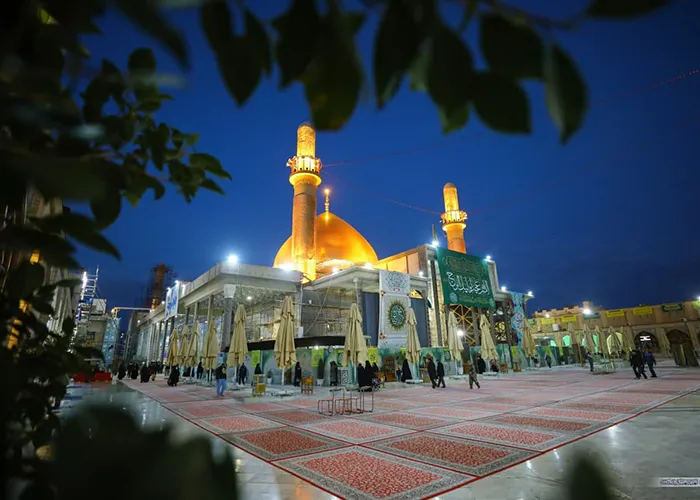Topic of the Week – Volume02 Issue33
Arbaeen: A Treasure of Spiritual Insight and a Centre for Religious Growth
Seyed Hashem Moosavi
Introduction
The pilgrimage of Arba’een to Imam Hussain (peace be upon him) is a unique phenomenon in the Islamic world, transcending mere mourning to become a focal point for the flourishing of knowledge and religious education. This article focuses on the intellectual and educational dimensions of Arba’een, examining the pedagogical teachings of this pilgrimage, the concept of guardianship-based education on the path to Karbala, the role of Arba’een as a school for faith, patience, and sincerity, and ultimately, practical education through the culture of walking as an exercise in servitude and faithful communal living. This study demonstrates that Arba’een offers a comprehensive educational system rooted in love for the Ahl al-Bayt (peace be upon them) and manifested in individual and social responsibility.
Section One: The Educational Teachings of the Arba’een Pilgrimage
The Arba’een pilgrimage, as a profound act of worship and social engagement, carries numerous educational teachings that profoundly affect the pilgrim:
- Monotheistic and Eschatological Education: Being present in the land of Karbala and witnessing the martyrdom of the oppressed reminds the pilgrim of Allah’s absolute power and His profound wisdom in testing His servants. These scenes strengthen faith in the Hereafter and divine accountability, teaching the pilgrim to take lessons from the fate of oppressors and the reward of the patient. «أَحَسِبَ النَّاسُ أَنْ یُتْرَکُوا أَنْ یَقُولُوا آمَنَّا وَهُمْ لَا یُفْتَنُونَ؛ “Do the people think that they will be left to say, ‘We believe,’ and will not be tested?” (Quran 29:2).
- Emotional and Compassionate Education: The pilgrimage embodies a profound emotional bond between the pilgrim and the one being visited, Imam Hussain (peace be upon him) and his loyal companions. This heartfelt connection instils love for God and His chosen ones in the pilgrim’s soul, inspiring them to emulate their moral virtues. Weeping for Hussain (peace be upon him) is the tears of love and divine knowledge, purifying the heart and erasing moral vices.
- Social Education and Empathy: The atmosphere of the Arba’een pilgrimage, particularly during the walk, is an unparalleled scene of empathy, brotherhood, and selflessness. Among crowds of strangers from diverse nationalities and languages, the pilgrim practically experiences and practices the concept of the “united Islamic Ummah” along with values such as self-sacrifice, helping others (even through offering a glass of water or providing shade), mutual respect, and the rejection of all forms of discrimination. This experience strengthens a sense of social responsibility and commitment toward others.
- Political Education and Resistance to Oppression: Visiting the grave of a martyr who stood against tyranny and corruption teaches the pilgrim lessons in resistance, courage, dignity, and fearlessness in the face of falsehood. Arba’een echoes Hussain’s motto, “هیهات منا الذله” (Never to humiliation!), keeping alive the awareness of preserving religious identity and confronting oppression and injustice.
Section Two: Guardianship-Based Education on the Path of Arba’een: From Love to Responsibility
The journey toward Karbala during Arba’een is a tangible manifestation of guardianship-based education. This education follows an evolutionary path that begins with love and culminates in responsibility:
- Foundation: Love for the Ahl al-Bayt (peace be upon them): The primary motivation for millions of pilgrims to endure the journey’s hardships is pure love for Imam Hussain (peace be upon him) and the family of the Prophet. This love is the driving force and the foundation for accepting divine guardianship (Wilayah), which, as the Quran states, is embodied in the Imams (peace be upon them): «قُل لَّا أَسْأَلُکُمْ عَلَیْهِ أَجْرًا إِلَّا الْمَوَدَّهَ فِی الْقُرْبَىٰ؛ “Say, ‘I ask of you no reward for it except love of [my] relatives.'” (Quran 42:23). This affection is the cornerstone of guardianship-based education.
- Knowledge: Understanding the Conduct and Objectives of the Imam (peace be upon him): Guardianship-based education is incomplete without knowledge. The environment of Arba’een provides an exceptional opportunity for study, listening, and discourse, acquainting the pilgrim with the various dimensions of the uprising of Ashura, the objectives of Imam Hussain (peace be upon him), including “reviving the command of God, enjoining good, and forbidding evil”, and the personalities of his loyal companions. This understanding elevates love from an emotional level to a profound and knowledge-based one.
- Following in Practice: By setting foot on the path to Karbala, the Arba’een pilgrim demonstrates in action that they are followers of Hussain’s (AS) path. They willingly endure the journey’s hardships (though minor compared to the trials of Karbala), participate in service processions (Mawakib), and strive to embody Hussaini ethics, such as patience, selflessness, and respect, throughout the pilgrimage. This practical adherence is the next stage of guardianship-based education.
- Culmination: A Sense of Responsibility: The pinnacle of guardianship-based education during Arba’een is the pilgrim’s realisation that love, and devotion entail responsibility in both personal and social life. Witnessing the grandeur of Hussain’s (AS) movement, the pilgrim recognises their duty to uphold faith, defend the oppressed, enjoin good and forbid evil, foster Islamic unity, and serve God’s creation. Hussain (AS) was martyred so that religion could endure; the pilgrim returns to embody its values in their society. This transformation is the goal of guardianship-based education on the path of Arba’een: turning love into responsible action.
Section Three: Arba’een; A School of Faith, Patience, and Sincerity
The spiritual atmosphere of Arba’een provides an unparalleled educational environment for strengthening the three fundamental pillars of religious devotion:
- The School of Faith (Strengthening Conviction)
- Tangible Experience of Faith’s Power: Witnessing millions of people from diverse backgrounds enduring the hardships of the journey solely for the sake of God and with shared faith serves as the most significant practical lesson on the power of belief and the magnetic pull of the Ahl al-Bayt’s (AS) guardianship.
- Strengthening Belief in the Unseen: Being in Karbala and visiting the shrine of Imam Hussain (AS) revives and fortifies the pilgrim’s belief in the unseen world, angels, intercession, and the spiritual impact of pilgrimage.
- Faith in Divine Promises: The patience and steadfastness of the Imam (AS) and his companions, followed by the eternal commemoration of Arba’een, embody the divine promise of victory for the believers and the permanence of truth: «إِن تَنصُرُوا اللَّهَ یَنصُرْکُمْ وَیُثَبِّتْ أَقْدَامَکُمْ؛“If you support God, He will support you and make your footsteps firm.” (Quran 47:7).
- The School of Patience (Perseverance for a Higher Purpose)
- Training in Enduring Hardship: The fatigue of the journey, exposure to heat or cold, crowded spaces, and separation from family all serve as opportunities to practice patience in the path of love and conviction. By recalling the extraordinary patience of Imam Hussain (AS), Lady Zainab (SA), and the other captives in the immense tragedy of Karbala, the pilgrim finds strength to bear their difficulties more easily.
- Patience in Obedience: The long walk and performance of pilgrimage rituals cultivate patience in fulfilling religious duties and acts of worship.
- Patience in Interaction: Tolerating occasional unintended behaviour from fellow pilgrims in crowded conditions trains one in forbearance and graciousness when dealing with others.
- The School of Sincerity (Purification of Intentions)
- Pure Intention for God’s Pleasure: At its core, the Arba’een pilgrimage is undertaken solely to seek divine approval and express devotion to His chosen ones. The prevailing spiritual environment compels pilgrims to purify their intentions from all traces of hypocrisy, desire for fame, or worldly gain.
- Sincerity Manifested Through Service: The spontaneously organised charitable stations (Mawakib) along the route, providing food, shelter and care without any material compensation, purely for God’s sake and to serve Imam Hussain’s (AS) pilgrims, stand as tangible manifestations of sincerity in action. Pilgrims learn this virtue both through giving and receiving these acts of devotion.
Section Four: The Culture of Walking; Training for Servitude and Faithful Collective Living
The Arba’een walk is a grand educational ritual with two fundamental dimensions:
- Training in Individual Servitude (Worship in Motion)
- A Reminder of Weakness and Need: The long journey on foot makes one acutely aware of physical limitations, dependence on food and water, and the inherent need for the Creator. This experience deepens humility and awe before divine greatness.
- Dhikr and Supplication: The walking path becomes a space for both private and communal remembrance. People recite prayers (like Du’a al-Ahd) and converse with God. The movement of the feet synchronises with the movement of the tongue and heart in divine remembrance.
- Training in Faithful Collective Living
- Rejecting Individualism: The Arba’een walk immerses the pilgrim in an ocean of humanity, teaching them that “I” am not alone, but part of a greater “We” bound by faith. This experience challenges extreme individualism.
- Solidarity and Unity: The convergence of diverse ethnicities, sects, and nationalities with a shared purpose embodies the Quranic ideals of «أُمَّهً وَاحِدَهً» “one Ummah” and «إِنَّمَا الْمُؤْمِنُونَ إِخْوَهٌ» “The believers are but brothers” (49:10). In this spirituality-centred journey, distinctions of colour, race, language, and nationality fade.
- Voluntary Service System (Mawakib): The vast, self-organised network of Mawakib stands as a peerless model of a society built on cooperation (ta’awun), sacrifice, division of labour, social responsibility, and selfless service: «وَتَعَاوَنُوا عَلَى الْبِرِّ وَالتَّقْوَىٰ؛“Cooperate in righteousness and piety” (5:2). Every pilgrim alternates between being a giver and receiver of service, experiencing both roles.
- Practising Collective Discipline: The orderly movement of millions along defined routes require spontaneous self-regulation and respect for others’ rights (to passage, rest, and shared resources), a practical training in communal ethics.
Conclusion
The Arba’een of Imam Hussain (AS) is a profound spiritual phenomenon, a dynamic and comprehensive system of divine knowledge and religious education that transforms individuals and societies alike. By awakening pure love for the Ahl al-Bayt (AS), this pilgrimage addresses the deepest layers of the human soul, setting the pilgrim on a journey that begins with love and culminates in a sense of personal and social responsibility toward faith and community.
Arba’een is a school without walls or borders, where:
- Faith is tested in the crucible of experience,
- Patience is tempered in the fire of hardship,
- Sincerity shines through selfless service to others.
Year after year, Arba’een paints a living, hopeful vision of a society founded on divine values. It prepares the pilgrim not just for the pilgrimage itself, but for a transformed life, thereafter, becoming a nucleus for human flourishing on the path of servitude and love.
editor's pick
news via inbox
Subscribe to the newsletter.




